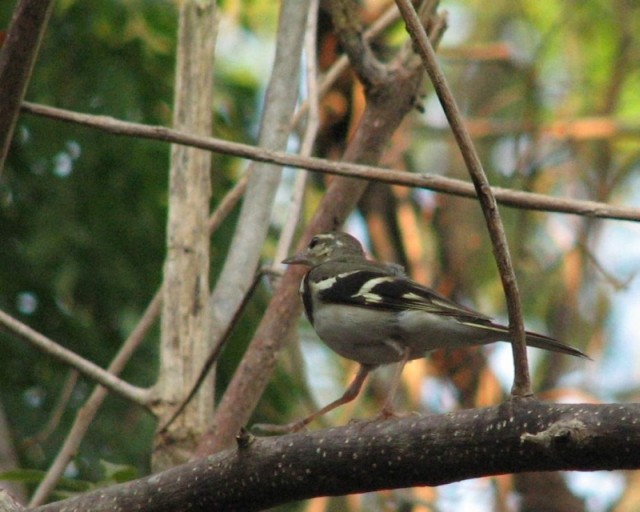Forest Wagtail
A species of Forest Wagtails Scientific name : Dendronanthus indicus Genus : Forest Wagtails
Forest Wagtail, A species of Forest Wagtails
Botanical name: Dendronanthus indicus
Genus: Forest Wagtails
Content
Description General Info
 Photo By അപ്പു , used under CC-BY-SA-2.5 /Cropped and compressed from original
Photo By അപ്പു , used under CC-BY-SA-2.5 /Cropped and compressed from original Description
This is a distinctive wagtail, the only one placed in the genus Dendronanthus (all other wagtails are placed in Motacilla). The forest wagtail is 18 cm in length, a slender bird with a long tail. The back and crown are olive brown, and the wings are black with two yellow wing bars and white tertial edges. There is a white supercilium, above a dark stripe through the eye. The underparts are white, apart from a black double breast band. The upper breast band is bib-like while the lower band is often broken. Sexes are similar. Young birds are more yellowish on the underside. 
Size
18 cm
Nest Placement
Tree
Feeding Habits
Forest Wagtail consumes various small invertebrates, including ants, beetles, grasshoppers, butterflies, cicadas, spiders, molluscs, and worms. Forest Wagtail forages on the ground and in trees, often running along paths and boughs. It displays a distinct swaying behavior when perched. Typically found alone or in pairs.
Habitat
Forest Wagtail resides in eastern Asia's various forest types up to 1800 meters elevation, including deciduous, evergreen, and riverine forests with clearings near streams. In winter, it migrates to warmer Asian regions, utilizing wooded agricultural lands, parklands, mangroves, and bamboo jungles. It also opportunistically forages in cattle yards and mudflats and roosts in communal areas like plantations and reed beds.
Dite type
Insectivorous
General Info
Feeding Habits
Bird food type
Behavior
These wagtails are found singly or in small groups. They often forage in the trees and capture insects along the branches of trees. They may also forage on the ground like a pipit and when disturbed, it flies up into the trees with a sharp pink note. They roost in the company of other wagtails among reeds. The song includes disyllabic tsi-fee notes repeated several times. They can climb steep branches and will run rapidly along horizontal branches. The breeding season is May in northeastern India and June in the Amur region. The forest wagtail leaves the winter quarters towards the end of March from Sri Lanka and mid March from the Malay Peninsula, the last birds leaving around May. During particularly cold springs, the arrival in the summer breeding grounds near the Kedrovaya River (Ussuri Land) can be as late as the end of May. Males sing from May to July, and when calling the bird sways at each syllable. It is the only wagtail that builds nests on trees, often favouring oaks. It builds its cup-shaped nest made up of fine grass and rootlets matted with moss and cobwebs. The nest is built by the female alone and the male stands guard nearby. The usual clutch is five eggs, incubated by the female alone for about 13 to 15 days. Incubation begins before the full clutch is laid and the eggs hatch at intervals. The young fledge and leave the nest after about 10 to 12 days. Both the males and females take part in feeding the young. Like other wagtails, this species is insectivorous. Apart from its unusual plumage pattern and habitat, the forest wagtail differs from its Motacilla relatives in its strange habit of swaying its tail from side to side, not wagging it up and down like other wagtails. The Japanese name Jokofury-sekirei (=sideways-swinging wagtail) ) is based on this habit. In Sri Lanka, they often search for maggots in cattle dung and for this reason are known as gomarita (=dung-spreader). The brown shrike (Lanius cristatus confusus) sometimes imitates the calls of the forest wagtail. 
Distribution Area
As its English and scientific names imply, this is a forest species, a distinction from all other wagtails. It is usually found in open areas of the woodland such as clearings. In winter it is found mainly in well-shaded forest habitats or along paths in coffee plantations and clearings in forests. The breeding areas are in eastern Asia, parts of Korea, parts of China (Kansu, Anhwei, Hunan) and parts of Siberia. Southern records of breeding from Assam have been questioned. It migrates to the warmer parts of Asia in winter and it has been suggested that they reach southern India and Sri Lanka via the Andaman Islands. It has been recorded as a vagrant in the Maldives. It was formerly thought to winter only in southwestern India, passing through the rest of the peninsula on migration. But now it has been shown to winter in all of the southern part of the peninsula in addition to southwestern India. 
Species Status
Not globally threatened.
Scientific Classification
Phylum
Chordates Class
Birds Order
Perching birds Family
Wagtails Genus
Forest Wagtails Species
Forest Wagtail